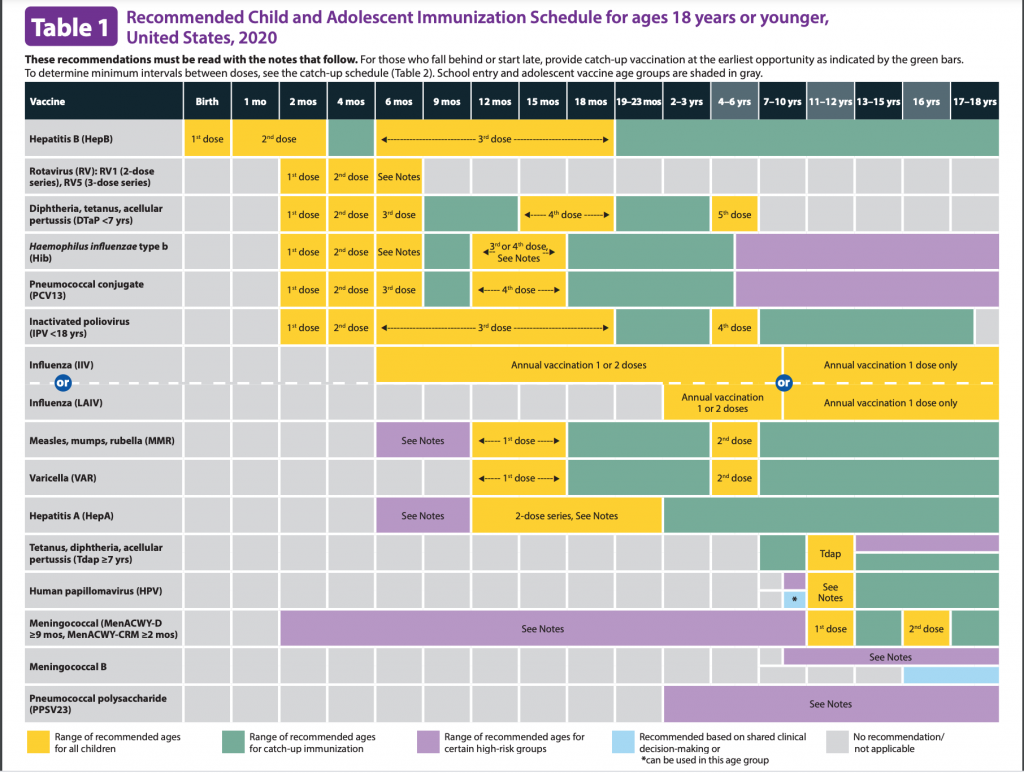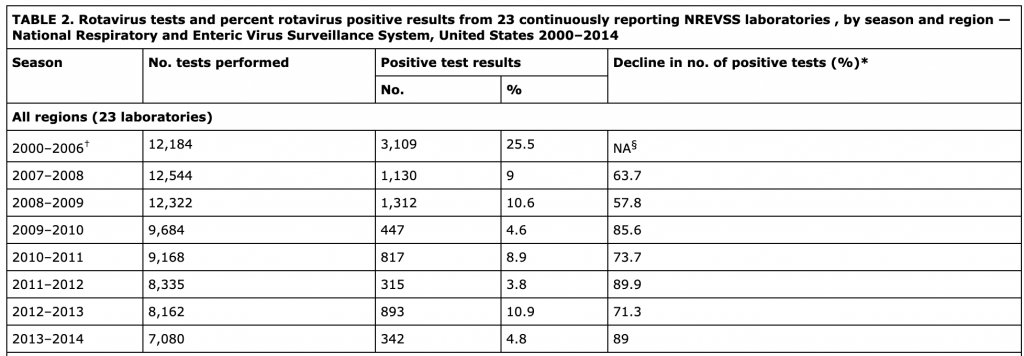What is rotavirus?
“A rotavirus infection usually starts within two days of exposure to the virus. Initial symptoms are a fever and vomiting, followed by three to eight days of watery diarrhea. The infection can cause abdominal pain as well. In adults who are otherwise healthy, a rotavirus infection may cause only mild signs and symptoms or none at all.” (Mayoclinic/diseases)
Here is a quick look at the CDC Recommended Vaccination Schedule for the US.

It is recommended to vaccinate children in the US against Rotavirus at 2mo, 4mo and potentially at 6mo as well. (It depends on the vaccine used. If it is Rotarix you do 2 doses, RotaTeq 3 doses)
Let’s look at some data of how many cases of Rotavirus there are each year. Look at the positive test results from 2013-2014. That year there were 342 cases of Rotavirus in all of the US. In 2013 there were 316.1 million people in the US. Your estimated chances of getting Rotavirus in 2013-2014 would have been about 1 in a million. Or divide 316,100,000 people by 342 cases for your chances of getting rotavirus: 1 in 924,269. The cases vary year by year so as a reference you can see some other past years as well.

Ok so now that it seems it is not that likely to get Rotavirus, let’s checkout the insert for RotaTeq for more information. Below are quotes directly from the insert….
This vaccine is a live virus. The next question naturally would be, can the vaccine spread the virus? “Transmission of vaccine virus strains from vaccinees to non-vaccinated contacts has been observed post-marketing.” So if you get the vaccine you can spread it.
But at least this vaccine will prevent my child from getting Rotavirus right? “RotaTeq may not protect all vaccine recipients against rotavirus.”
Has the vaccine been evaluated for carcinogenesis, mutagenesis, and impairment of fertility?
“RotaTeq has not been evaluated for its carcinogenic or mutagenic potential or its potential to impair fertility.”
Were there post market adverse reactions reported? (Refer to the insert for all reactions reported post marketing.) ” Gastrointestinal disorders: Intussusception (including death)”
Ok now that you looked at the insert, let’s see what the Merck Patient information sheet has to say about RotaTeq Vaccine. First it says, “Read this information carefully before your child receives each dose of RotaTeq®”.
“Reports of infants with intussusception following RotaTeq have been received by the Vaccine Adverse Event Reporting System (VAERS). Intussusception occurred days and sometimes weeks after vaccination. Some infants needed hospitalization, surgery on their intestines, or a special enema to treat this problem. Death due to intussusception has occurred.”
Lastly let’s talk ingredients, what is in the vaccine(s)…

If you are wondering what PCV virus is since these vaccines have this virus in them, well I was wondering too and checked it out. “Subsequently, PCV isolates from diseased pigs were designated as porcine circovirus type 2 viruses (PCV2) and the original PCV from PK-15 cell cultures as porcine circovirus type 1. PCV2 has been further associated with a number of disease syndromes in pigs…” (MerckCircovirus). So each child gets that extra bonus with these vaccines it appears, hmmm
Ok so now you have a little more info about Rotavirus. Hopefully this gets you at least a little bit curious to dig more and to make an informed decision about this vaccine….